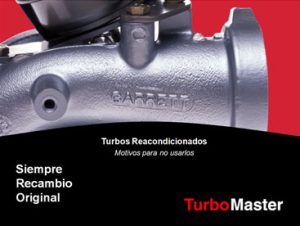Always Genuine Parts – Reconditioned turbochargers: reasons not to use them

Download Garrett® Turbo Reconditioning Report
Summary of presentation contents
Index
- Comparison between a Garrett® VNT™ turbocharger and a reconditioned VNT™ turbocharger
- Case Study
- Visual analysis
- Component Comparison
- Display
- Comparison between a Garrett® turbo and a counterfeit turbo
- What is the difference between a copy and a counterfeit turbo?
- Visual Analysis
- Component Comparison
- How it affects engine performance
Case study
Visual analysis
Valve stem
The stem controls the movement of the variable geometry nozzle.
- El vástago es una pieza crítica para el correcto funcionamiento del turbo y para el rendimiento del motor.
Valve Stem Surface Finish
Valve ( Dust and water seal )
Valve surface finish
Inside Valve
Reconditioned Valve – Potential Hazards
- Seizure of the system that controls the movement of the blades and premature wear.
- Rapid corrosion and failure of internal components.
- Failure of the diaphragm in a short period of time.
- No control on the VNT™ mechanism
- Low engine performance
- Excess emissions
- Excess exhaust temperature
- Engine damage
- Spring breakage
- Turbo may over-rev
- Total failure and possible engine damage.
- Turbo may over-rev
- It is impossible to evaluate its service life
Exhaust Cone – Nozzle Ring
Exhaust cone – Contact surface
Adjacent to the blades
Nozzle ring
Poor surface finish
7 of 9 blades incorrect
- Out of tolerances
Irregular dimensions
- Out of tolerances
Blade tips bent inwards
- Out of tolerances
POTENTIAL RISKS
Restriction of nozzle movement can cause permanent debris in the nozzle, reducing engine performance. Impacts turbo performance at low rpm, decreasing engine performance at low speed.
Exhaust segment
The segment is used to prevent oil and exhaust gases from leaving and entering the turbo.
The reconditioned turbo has a segment with incorrect clearance between tips.
- Out of tolerances
Unknown material
POTENTIAL RISKS
Depends on operating conditions:
- Exhaust gas inlet inside the turbocharger
- Increased pressure in the turbo drain and crankcase
- Oil leakage through the exhaust casing
Possible risk due to use of incorrect material
- Segment deformation
- Rotor contact
Plate
Screws overtightened
- Damaged sealing area
Notes:
- Honeywell chuck holes have a flat surface.
- The Honeywell chuck screws have bosses that are driven into the flat aluminum surface of the chuck, achieving a perfect seal.
POTENTIAL RISKS
- Oil leakage from the body to the inlet cowling
- Oil contamination of the air intakes and intercooler
- Oil burning during combustion
- Out of specification emissions
Conclusion
Consequences on Engine Performance














